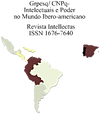Ouroborus’ snake as memory in Architecture: Oscar Niemeyer and the “ark of saved memories”
Keywords:
Memory in Architecture, Oscar Niemeyer, Theory of Architecture.Abstract
Memory is the primordial soupfor the creative act and design inarchitecture. Memories of the architect, asindividual, act as pillars and foundations ofa work of architecture, and this as a mirrorof experiences about the creative minds.This article approaches around the theme ofmemory in Architecture, and aims todemonstrate that the architect uses a“drawer of the saved memories”, build,“living” or “manufactured” ones, dependingon the degree of presence of the object, andwhich it uses according to “unconscious”memories or “’conscious’ active”,according to physiological data, intrinsic tohis intellectual maturation processes, and isalways a base for his life path - the innerconstruction: the drawer from the drawer.For this example, the architect OscarNiemeyer is used to illustrate the impact ofmemory of the architecture on the designprocess: an evidence of the importance ofthe primordial house (first memories of/forthe architecture), the intra and extra mainplanning relations between the individual,political affiliation, their ideals and theirpersonal training in designing as searchprocesses and use of existing memories.Niemeyer, considered by many as therepresentative symbol - often up to the highstatus icon – for the spontaneous creation ofideas driven by imagination, is analyzed inall dimensions of his speech - from theinterview, writing and project. It will beexplored, thus, the validity of “spontaneouscreation.” Being the creative process an actof integrated design, it also intends to showthe origin of the architect, the architectureand the relationship between them: “home”(as is) as the primary trial between livingmemory and the constructed memory.These crossings common to architects anddifferentiated in each individual mirror theapparent and disguised uniqueness of thecreative process. But other voices, such asarchitect Frank Gehry, Ruskin, the artistEleni Basteá, writers Jorge Luis Borges andthe essayist Montaigne, show that creativeprocess is the result of a link and also a linkbetween past and future memories. In thispremise, there is no spontaneous creation -the invention is purely speculative and not real.Downloads
Download data is not yet available.
Downloads
How to Cite
NUNES, José Carlos Rodrigues Avelãs. Ouroborus’ snake as memory in Architecture: Oscar Niemeyer and the “ark of saved memories”. Intellèctus, Rio de Janeiro, v. 13, n. 1, p. 44–67, 2015. Disponível em: https://www.e-publicacoes.uerj.br/intellectus/article/view/18220. Acesso em: 14 may. 2025.
Issue
Section
Artigos Livres
License
Autores que publicam nesta revista concordam com os seguintes termos:
Os autores mantêm os direitos autorais e concedem à revista Intellèctus o direito de publicação, sob uma Licença Creative Commons Atribuição 4.0 Internacional, a qual permite que outros distribuam, remixem, adaptem e criem a partir do seu trabalho, mesmo para fins comerciais, desde que lhe atribuam o devido crédito pela criação original.
Os dados e conceitos abordados são da exclusiva responsabilidade do autor.
A revista Intellèctus está licenciada com uma licença Creative Commons Atribuição 4.0 Internacional





